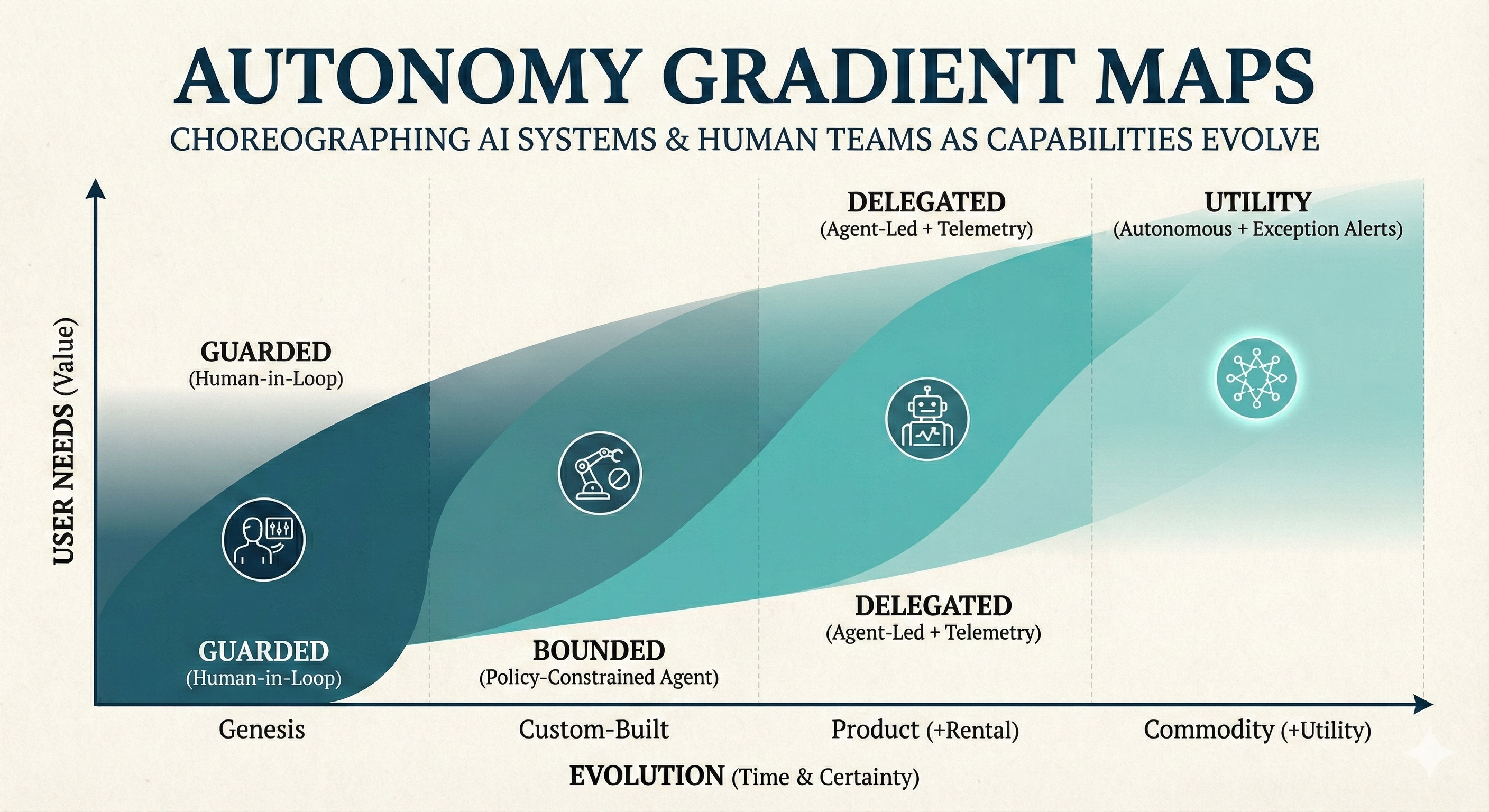Autonomy Gradient Maps
AI is compounding faster than governance. Leaders need a tool that lets them accelerate delegation without drifting into risk. Autonomy Gradient Maps extend Wardley Maps with explicit bands of delegated authority, showing how much control a component should have at each stage of evolution. The gradient creates an operational contract between human teams and AI agents: what they may decide, what they must escalate, and how that posture should change as the landscape shifts.

This model sits alongside the other AI-era operating patterns on this site. Where Cybernetic AI Leadership with the Viable System Model wires recursive governance, Autonomy Gradient Maps provide the map-level annotations that tell each System 1–5 node how much freedom to grant. They also complement Background AI for Continual Improvement by declaring where background agents can act without approval, and Autonomously Executed Strategy by defining the evidence gates that convert intent into safe machine-led execution. Together they form a choreography: recursive cybernetic loops, background AI improving the organism, and autonomy bands deciding how boldly the system acts.
Why autonomy gradients now
Most organisations still treat autonomy as a binary—either a system is fully manual or fully automated. In the AI era, that toggle creates brittle governance. Models drift, context changes, and a capability can leap from custom-built to utility in a single quarter. An Autonomy Gradient Map shows the safe corridor for delegation as components evolve, preventing overreach in Genesis and under-delegation once a service is commoditised.
Autonomy gradients also resolve a common leadership tension: how to keep pace with competitors without surrendering oversight. By making autonomy an explicit dimension on the map, leaders can forecast governance moves with confidence instead of guessing when to loosen or tighten control.
The Autonomy Gradient framework
- Map the value chain. Build or refresh the Wardley Map for the user need. Ensure components are placed on the evolution axis.
- Define autonomy bands. Create four bands for decision rights: guarded (human-in-loop), bounded (policy-constrained agent), delegated (agent-led with telemetry), and utility (autonomous with exception alerts).
- Overlay the bands on evolution and consequence. Draw the default gradient so that Genesis leans heavily to guarded, Custom-Built to bounded, Product to delegated, and Commodity/Utility to utility. Then modulate by consequence severity: low-consequence commodities can sit in utility; high-consequence commodities can stay bounded or delegated to keep human accountability. The gradient is not fixed; components can move against the default if risk, regulation, or ethics demand it.
- Attach evidence gates. For each component, specify the evidence required to shift bands: test coverage, red-team reports, model cards, scenario simulations, or third-party attestation. AI can automatically generate and verify much of this evidence.
- Instrument decision corridors. Use policy engines and guardrail services to enforce the current band. Telemetry should emit "approaching band boundary" signals when confidence or observability drops.
Resolving the commodity autonomy tension
A single left-to-right gradient hides the tension between efficiency and consistency. Commodities are stable enough to automate, yet many are also brand-defining or regulated. Make autonomy two-dimensional: evolution stage and consequence severity. Then pick the band at the intersection:
| Evolution | Low Consequence | High Consequence |
|---|---|---|
| Genesis | Bounded (policy-constrained) | Guarded (human-in-loop) |
| Custom | Delegated (agent-led + telemetry) | Bounded |
| Product | Delegated | Bounded |
| Commodity | Utility (fully autonomous) | Delegated or Bounded |
Examples: payment processing (commodity, high consequence) stays bounded with human-led fraud overrides, while static content delivery (commodity, low consequence) can be fully autonomous with exception alerts. Novel AI experiences (Genesis) remain guarded regardless of consequence to prevent premature delegation.
Applying the gradient
- Portfolio steering. When roadmap items appear, place them on the map and assign their initial autonomy band. This stops over-automation of risky Genesis experiments and prevents late-stage utilities from getting stuck in manual sign-off loops.
- Incident response. During outages or surprising AI behaviour, temporarily shift affected components one band tighter. The map makes the move visible and reversible, reducing fear-driven freezes that stall delivery.
- Cross-functional alignment. Security, legal, and product teams see the same autonomy posture and the evidence gates that justify it. Disagreements about risk appetite become tractable because they are linked to map positions and measurable signals.
Confident foresight through AI
Autonomy Gradient Maps pair naturally with AI simulation. Fine-tuned agents can simulate shifts in demand, regulation, or adversary tactics and propose band adjustments before humans feel the pain. Leaders get a shortlist of pre-validated moves: where to pre-approve bounded-to-delegated transitions, which utilities need renewed safety cases, and which Genesis probes should stay guarded until more data arrives.
Leadership moves
- Bake gradients into OKRs. Tie objectives to moving specific components through evidence gates, not just shipping features. This aligns incentives with safer delegation.
- Run cadence reviews. In every mapping session, ask which components earned a band shift. Celebrate progress to delegated or utility status to reinforce automation as an achievement, not a threat.
- Automate guardrails. Use AI to watch telemetry for pattern breaks (drift, bias, latency spikes) and automatically trigger band reversions with human notification.
- Connect to operating models. Assign Pioneers to guarded/bounded work, Settlers to shepherd delegated transitions, and Town Planners to industrialise utilities. The gradient clarifies who owns what across the evolutionary lifecycle.
Autonomy Gradient Maps give leaders a shared picture of how to pace AI delegation. By combining Wardley Mapping's situational awareness with explicit autonomy bands and AI-backed foresight, organisations can scale automation without surrendering agency or trust.
